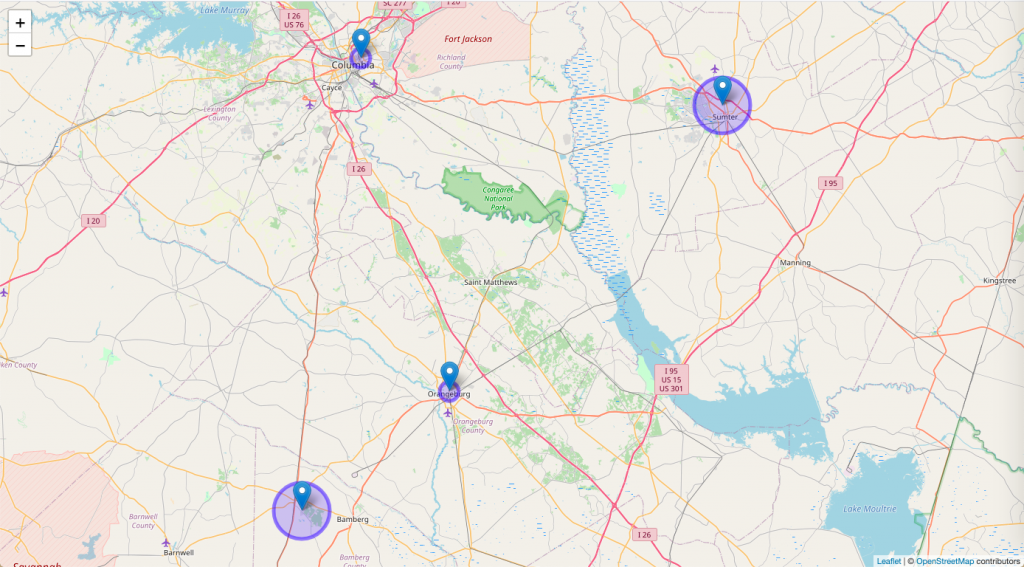Introduction
The booming market for political advertisements on digital platforms remains dominated by two major players, Facebook and Google. Together, Donald Trump and Joe Biden have spent nearly $300 million on ads run on these platforms since mid-April. However, a new player may be emerging in social media app Snapchat, which boasts an audience of 249 million daily active users and has shown significant levels of political advertisement activity.
Snap Inc., the parent company behind Snapchat, recently made waves in the stock market after posting record earnings in the third quarter. Analysts attributed this growth to both a surge in average ad prices, up 20 percent in the past year, and an increased demand from advertisers.
Unlike some competing platforms, Snapchat has also embraced political advertisements. According to Jeremi Gorman, Snap’s chief business officer, the platform is “actively going after” this market.
Much of Snapchat’s appeal for advertisers may come from its young user base. While Snapchat has fewer users overall than Facebook, the company claims to reach 90 percent of 13 to 24 year-old Americans, which would be more than Facebook, Instagram, and Facebook Messenger combined.
Also, significantly for political advertisers, Snapchat reports that 80 percent of its U.S. users are old enough to vote. As polling data suggests the 2020 election could be heavily swayed by a wave of young voters, Snapchat’s “Gen Z” audience might be particularly valuable for campaigns looking to galvanize this demographic.
Despite its large user base, Snapchat has received relatively little attention in research on political advertisements. However, the app maintains an archive of political ads with a remarkable degree of transparency. The level of detail available in this archive exceeds that provided by other platforms, namely Facebook. In the following article, I will outline what a glimpse into Snapchat’s ad library reveals about the state of digital advertising by presidential candidates.
Biden leads Snapchat ad spending
Although the budget presidential candidates have allocated towards Snapchat is relatively low, detailed data from the app’s Political Ads Library reveals a willingness of these campaigns to test the waters. 2020 presidential candidates with a current or past presence on Snapchat include Biden, Mike Bloomberg, Trump, Pete Buttigieg, and Elizabeth Warren. Among this group, Biden leads spending with over $3 million as of October 26, 2020
Despite withdrawing from the race in early March, Bloomberg remains the candidate with the second highest overall amount spent on Snapchat. This can be attributed to a $1 million flurry of ads his campaign ran on the platform in February.
Table 1: Total spend and impressions for presidential candidates in the Snapchat 2020 Political Ads Library as of October 26, 2020
For an overview of how presidential ads were identified, see “Methodology — Defining Official Presidential Advertisers.”
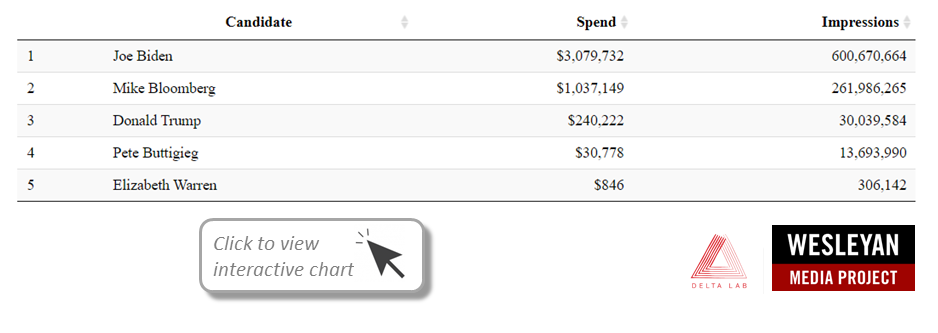
Biden’s activity on Snapchat has increased dramatically as the election approaches. Since August 25th, the Biden campaign has spent about $2.9 million on the platform. This two month period accounts for 96 percent of his total spending on Snapchat across all of 2020.
Figure 1: All Snapchat ads from official groups affiliated with 2020 presidential candidates
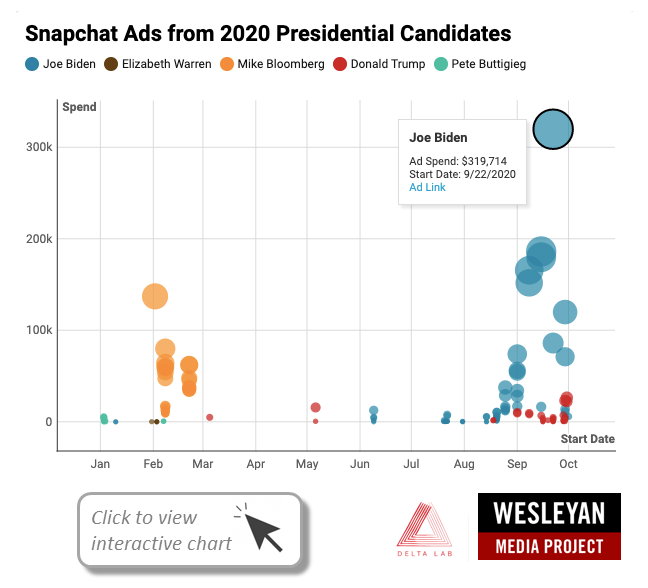
Many of these Biden advertisements contain imagery of recent fires on the West Coast paired with an attack on President Trump (see: “Climate Arsonist”). Others address the rising death toll from COVID-19 (see: “Do your job”).
Trump, the third highest spender on Snapchat, also increased activity in recent months, but to a much lesser extent. Over the same two-month time period, Trump spent about $213,000 on Snapchat advertisements. These short ads levy attacks on Biden’s economic policies (see: “An economy in ruins”) and trustworthiness (see: “I voted for Hillary”).
Table 2: Snapchat Ads Run by Biden and Trump in 2020
Ads are aggregated by URL and date, so targeted regions have been compiled into a list.
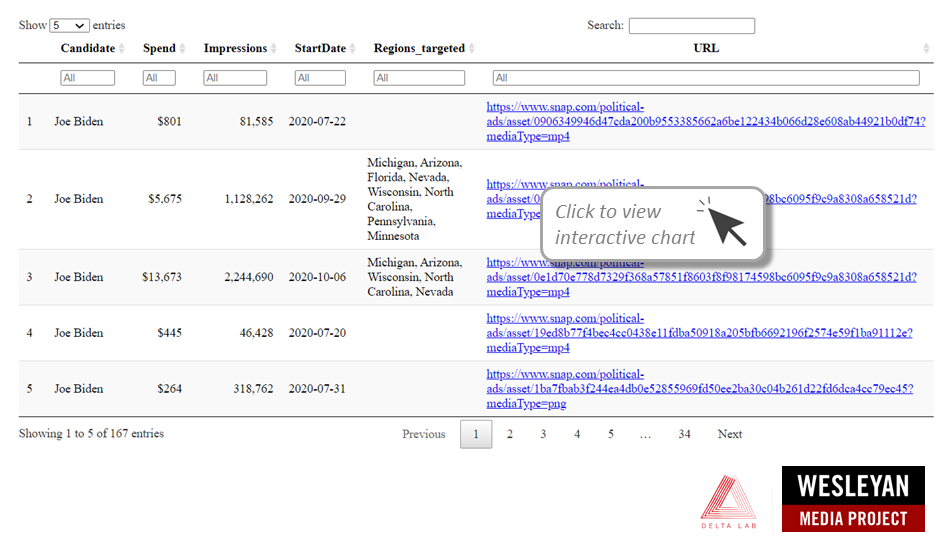
Geotargeting
The Snapchat Political Ads Library publicly provides detailed information for each ad, including content, targeting details, delivery, spend, and other campaign information. Geographic data on where the ad was run can be very precise because Snapchat gives advertisers the option of targeting specific latitude and longitude coordinates and running the ad on devices within a certain radius of that point. Other options include targeting locations by postal code and by “region,” which in the U.S. refers to states.
The preferred geotargeting technique of presidential candidates on Snapchat seems to be selecting audiences by region, or state. Eighty-eight percent of presidential candidate ads in the archive utilized region targeting.
Political advertisers rarely employ the more precise tactic of “radius targeting” by coordinates on Snapchat. Across the entire archive, only 4 percent of ads used radius targeting. Among presidential candidates, this number is less than 0.5 percent.
Though less common, radius targeting provides valuable insight into the particular objectives campaigns may have. For example, the Biden campaign ran a series of ads in South Carolina from January 10th to 16th that targeted four coordinates and their surrounding one or three mile areas (see: Figures 2 & 3). In this case, each location chosen by the Biden campaign corresponds to a historically black college or university (HBCU) campus.
Figure 2: Biden Targeting of HBCUs in South Carolina
Ads run by the Biden campaign prior to the South Carolina primary targeted Snapchat users within 1-3 miles of four HBCU campuses in the state (Benedict College, South Carolina State University, Voorhees College, and Morris College).
The advertisements themselves contain a message clearly catered towards students at these schools: “Joe Biden is ready to invest $70 billion in HBCUs and minority-serving institutions — an investment in your future.”
Overall, these ads cost the Biden campaign 217 dollars and garnered 51,343 impressions.
Figure 3: This ad from the Biden campaign was run at each of the four HBCU campuses.

Interest Targeting
Snapchat provides further opportunities for advertisers to target specific audiences with their “interests” feature, which uses in-app activity to categorize users into demographics ranging from Fox News watchers, to vegans, to basketball fans.
In total, 15 percent of all ads in the archive—and 8 percent of those from presidential campaigns—utilized interest targeting.
Table 3 displays the unique combinations of interests targeted by presidential candidates, along with the associated ad URLs, total spend, and total impressions for that grouping of interests. The dates in the “Ad URLs” column signify the first time that particular advertisement appeared in the archive. If a row has multiple links, this means the campaign ran multiple ads for the same interests combination.
Table 3: Presidential Candidate Ads Utilizing Snapchat’s Interest Targeting Feature
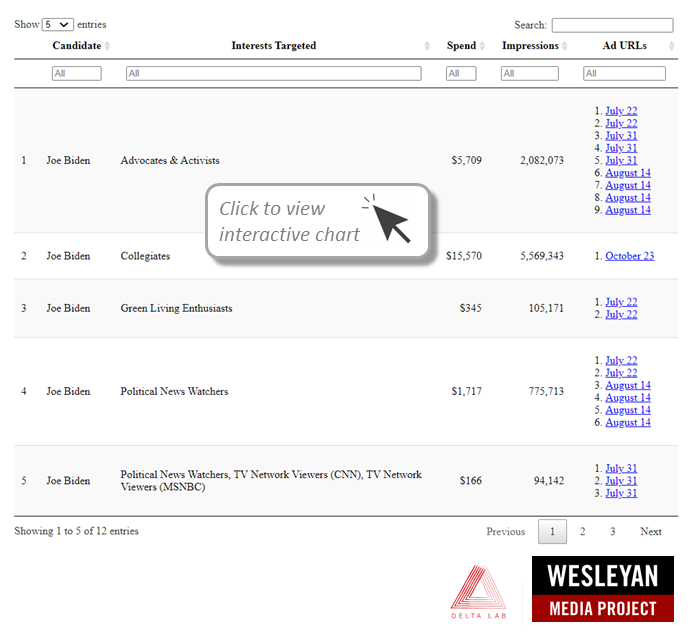
An analysis of this data reveals that Biden, Bloomberg, and Buttigieg each employed interest targeting for a small percentage of their ads.
Of the three, Bloomberg spent the most on interest-targeted advertisements with a total of about $150,000. This budget went exclusively towards a single grouping of interests, which included “Bookworms & Avid Readers,” “Green Living Enthusiasts,” “Political News Watchers,” and “Outdoor & Nature Enthusiasts.” Fittingly, each of the six ads Bloomberg targeted at this demographic covered environmental issues (see: “The Climate Threat is Real”, “Her Species Has No Future”, and “Planet Going to S***”).
Biden most frequently targeted “Advocates & Activists,” “Political News Watchers,” and “TV Network Viewers (MSNBC).” As the broad interest labels suggest, these Biden ads appeared to be relatively generic (see: “Join Joe’s Team”).
Figure 4: Bloomberg Ad Targeting Environmentalists
This video ad from the Bloomberg campaign ran on Snapchat in late February. Using in-app activity data provided by Snapchat, the advertisement targeted an audience of environmentalists.

Buttigieg targeted the same general interest groups as Biden, but additionally ran ads for “Collegiates” and a grouping of “Hip Hop fans” and “TV Network Viewers ([Black Entertainment Television]).” With the latter group of advertisements, Buttigieg appears to have sought an African American audience, as these ads contain repeated references to systematic racism (see: “Consequences of Racial Inequity” and “Generational Theft”).
Like Biden’s HBCU advertisements, these ads from Buttigieg ran in South Carolina leading up to the state’s primary election. In South Carolina, African American voters comprise up to 60 percent of the Democratic electorate, making this a crucial bloc for campaigners. Biden ultimately sealed a victory in South Carolina’s primary by receiving nearly two-thirds of the African American vote.
Race is notably not included in Snapchat’s user demographic data, but the microtargeting tactics of Biden and Buttigieg may represent an attempt at extrapolating this information using the available data like location and interests.
Figure 5: Buttigieg Ad Addressing Racial Inequity
A series of advertisements from the Buttigieg campaign targeted users identified by Snapchat as Hip Hop music fans and viewers of BET. In this example, Buttigieg discusses the racial diversity of South Bend and says, “Far too many people live with the consequences of racial inequity that has built up over centuries.”

Conclusion
While Snapchat activity from 2020 presidential candidates has remained relatively low by the immense standards of digital advertising, a recent increase in spending from the Biden campaign suggests the platform may soon share more of the spotlight.
Examples from the Biden, Bloomberg, and Buttigieg campaigns illustrate the advanced audience targeting functionality Snapchat provides its advertisers with. In addition to the location and interest targeting techniques covered here, advertisers may further curate their audiences on Snapchat with fields such as gender, age, device type, and language. Some ads in the archive even contain the variable “Advanced Demographics,” which captures user characteristics like household income, marital status, education level, and occupation.
However, what sets Snapchat apart from Facebook and other digital advertising platforms may not be its availability of microtargeting techniques so much as its transparency in providing this data publicly. In fact, Facebook gives advertisers similar, if not more detailed, ad targeting capabilities, but the data shared by their Ad Library API does not divulge any demographic targeting information other than gender, age, and location. By contrast, Snapchat’s comprehensive archive and documentation give the platform an edge in terms of transparency.
Methodology – Defining Official Presidential Advertisers
Snapchat reports both the “Organization Name” and “Paying Advertiser Name” for ads in its archive. The former denotes the name of the organization responsible for creating the ad, while the latter is the name of the entity providing funds for the ad. To mark whether an ad came from a presidential campaign, I searched for official paying advertiser names. Sometimes, candidates have multiple funding entities. Ads from Joe Biden aggregated those from the paying advertisers “Biden for President”, “Joe Biden for President”, and “Biden Victory Fund”. Ads from Donald Trump aggregated those from the paying advertisers “Trump MAGA Committee” and “Donald J. Trump for President”. No other presidential candidate in this report had multiple advertiser names.
Spencer Dean ‘21 studies Psychology and Applied Data Science at Wesleyan University. His research contributions to the Wesleyan Media Project have primarily focused on political Facebook advertisements.


